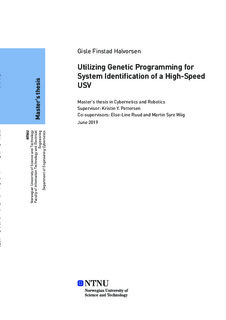| dc.contributor.advisor | Pettersen, Kristin Y. | |
| dc.contributor.advisor | Ruud, Else-Line | |
| dc.contributor.advisor | Wiig, Martin Syre | |
| dc.contributor.author | Halvorsen, Gisle | |
| dc.date.accessioned | 2019-10-31T15:06:23Z | |
| dc.date.issued | 2019 | |
| dc.identifier | no.ntnu:inspera:35771502:32550399 | |
| dc.identifier.uri | http://hdl.handle.net/11250/2625689 | |
| dc.description.abstract | Ved utforming av et fartøys kontrollsystem er en tilstrekkelig nøyaktig modell viktig for både kontrollstrategi og simuleringer. For marine høyhastighetsfartøyer er ikke modellering en triviell oppgave. Dynamikken til en USV endrer seg i de forskjellige fasene, fra forskyvningsfasen der oppdriftskreftene dominerer hydrodynamikken, til planingsfasen hvor den aerodynamiske løftekraften og luftmotstanden begynner å ha en innvirkning på systemet.
I denne avhandlingen presenteres en tilnærming til dette modelleringsproblemet ved å benytte den datadrevne metoden genetisk programmering. Ulike verktøy for å implementere algoritmen i kode er undersøkt på et enkelt system. Algoritmenes evne til å finne den riktige løsningen med støyete data blir også undersøkt, og viser lovende resultater. Genetisk programmering ble testet på et system med lignende kompleksitet til det virkelige systemet for å lettere analysere algoritmens styrker og svakheter.
Metoden brukes på data tatt opp av båtens sensorer, for å modellere fartøyet. To fartøysmodeller er utledet, hvor man i den ene betrakter aktuatorkraften som input til systemet, og utelukker dermed aktuatordynamikken fra modellen. Den andre modellen vurderer styresignalene, som sendes fra autopiloten til aktuatorene som input til systemet. Dermed inneholder den andre modellen aktuatordynamikken i modellen. Modellene passer bra til valideringsdataene, og kan dermed betraktes som nøyaktige nok for simulering og kontroll formål. | |
| dc.description.abstract | When designing a vehicle control system, a sufficiently accurate model is important for both control strategy, and simulations. For high-speed marine vessels, modelling is not a trivial task. The dynamics of the USV changes in the different phases, going from the displacement phase where the buoyancy forces dominate the hydrodynamics, to the planing phase where the aerodynamic lift and drag forces starts playing a role.
In this thesis, an approach to this modelling problem is presented, utilizing the data-driven method genetic programming. Different tools to implement the algorithm in code are examined, on a simple system. The algorithm's ability to find the correct solution with noisy data is investigated and shows promising results. Genetic programming was tested on a system with similar complexity to the real system to easier analyze the performance and weaknesses of the algorithm.
The method is used on data captured by the vehicle's sensors, in order to model the vehicle. Two vehicle models are derived, where one considers the actuator force as the input to the system, thus excluding the actuator dynamics from the model. The other model considers the control signals, sent from the autopilot to the actuators as the input to the system. Hence, the second model includes the actuator dynamics in the model. The models show decent goodness of fit on the validation data, and can be considered accurate enough for simulation and control purposes. | |
| dc.language | eng | |
| dc.publisher | NTNU | |
| dc.title | Utilizing Genetic Programming for System Identification of a High-Speed USV | |
| dc.type | Master thesis | |
